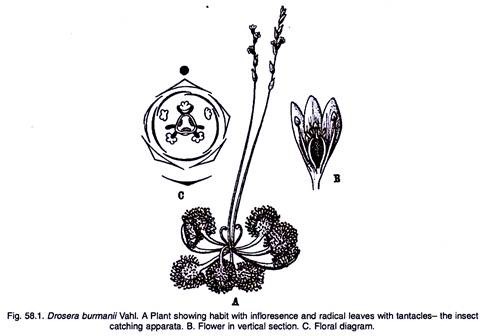In this article we will discuss about:- 1. Characters of Droseraceae 2. Distribution of Droseraceae 3. Economic Importance 4. Affinities.
Characters of Droseraceae:
Perennial creeping insectivorous herbs; rosulate leaves; flowers hermaphrodite, pentamerous, hypogynous.
A. Vegetative characters:
Habit:
Annual or perennial glandular, creeping insectivorous herbs or rarely subshrubs of marshy places.
Root:
Primary root is absent in some species, its place is taken by protocorm-like structure developed from hypocotyl and it bears filiform attaching organs e.g., Drosera. Drosophyllum and Dionaea have primary roots.
Growth forms:
According to different climatic conditions and consequent factors two types of growth forms of family Droseraceae such as geophyllous and photophyllous are recorded.
The geophyllous types are adopted to climates where damp cold season alternates with dry hot season, e.g., D. cistiflora and D. paucciflora and they persist by means of swollen root or bulb as the case may be.
In photophyllous type e.g., Drosera indica L. the axis is capable of indefinite growth by means of terminal bud.
Stem:
Underground or woody, branched.
Leaf:
Alternate, very rarely whorled, usually in basal rosettes often circinate in bud; both surfaces (expect in Dionaea) generally covered with viscid stalked glands responsible for trapping small insects, stipules mostly present, membranous.
B. Floral characters:
Inflorescence:
Solitary or spike or raceme to paniculate determinate inflorescence (often mistaken to be true raceme or panicle).
Flower:
Actinomorphic, hermaphrodite, hypogynous, tetra or pentamerous.
Calyx:
sepals 4-5, basally connate, persistent, imbricate.
Corolla:
Petals 5, distinct, convolute imbricate, membranous or soft.
Androecium:
Stamens 5-20 in one or more pentamerous whorls, free distinct or rarely the filament basically connate; anthers bithecous, dehiscing longitudinally extrorse, pollen in tetrads.
Gynoecium:
Carpels 3-5, syncarpous, superior, sometimes nearly half inferior, parietal placentation, unilocular; styles 3-5, mostly free, distinct, often forked or branched, stigma as many as stylartips. capitate; ovules numerous, anatropous.
Fruit:
Loculicidal capsule.
Seed:
Numerous, embryo straight, endosperm cystalline-granular.
Pollination:
Entomophilous.
Floral formula:
Distribution of Droseraceae:
Sundew family of 4 genera and perhaps 90 species. Three of genera are monotypic Drosophyllum, Dionnea and Aldrovanda. Drosera, with perhaps 85-88 species and most abundant in Australia. Drosera is available on all continents. It is found in abundance in the wastelands fringing upon the road from Giridih to Parashnath Hills, Bihar.
Economic Importance of Droseraceae:
The family is of little or no economic importance.
1. Dye:
The leaves of Drosera yield a violet dye; but no longer of commercial importance.
2. Ornamental:
Dionaea (Venus-flytrap) is grown and sold in trade as a novelty.
Affinities of Droseraceae:
The systematic position of Droseraceae is rather controversial. Diels due to parietal placentation of Droseraceae has put it under parietales with relationship with Violaceae, which has been supported by Wettstein.
Hallier, Engler and others placed the three families viz., Sarraceniaceae, Nepenthaceae and Droseraceae into one order Sarraceniales next to Rhoeadales.
Common plants of the family:
1. Aldrovanda – Rootless, swimming water plant.
2. Drosera – Sundew a widely distributed genus.
3. Dionaea – Venu’s fly-trap.
The leaf tends to close abruptly by insect stimulation.
Morphology of tentacle:
Morphologically a tentacle is intermediate between true leaf part and a trichome (filamentous hair like outgrowth). Its structure differs according to its situation either on the margin or surface; everywhere a tentacle is provided with vascular chord-a tracheid ending in a gland, the tracheid end covered by two layers of secreting mantel composed of secreting epithelium.
These tentacles play an important role as attracting objects of insects and as gripping hold for the same. The tentacles have peculiar power of movement and curving. As insects get struck into the mucilaginous secretion of glands the tentacles bend down over the body of imprisoned prey and take a firm grip.
